Surveying the management practices and research needs of graziers in the New England region of New South Wales
G. Kaine A E , B. Doyle B , H. Sutherland C and J. M. Scott DA Victorian Department of Primary Industries, Private Bag 1, Tatura, Vic. 3616, Australia.
B RMTeK Pty Ltd, 90 Taylor Street, Armidale, NSW 2350, Australia.
C ‘Deeargee’, Uralla, NSW 2358, Australia.
D School of Environmental and Rural Science, University of New England, Armidale, NSW 2351, Australia.
E Corresponding author. Email: geoffkaine@yahoo.com.au
Animal Production Science 53(8) 602-609 https://doi.org/10.1071/AN11170
Submitted: 8 August 2011 Accepted: 9 December 2011 Published: 29 May 2012
Journal Compilation © CSIRO Publishing 2013 Open Access CC BY-NC-ND
Abstract
The inaugural committee of the Cicerone Project commissioned a survey of livestock producers in the New England region to determine the research problems and production practices which were of greatest importance to graziers. In addition, an assessment was made of the level of interest livestock producers had in participating in a proposed producer-led research and adoption project. The survey was mailed to livestock producers in five districts across the New England region during October and November 1997. The survey results concerning land and pasture management issues suggested that a majority of livestock producers in the New England region found the challenges of dry seasons, fertiliser use, pasture composition and pasture persistence to be major problems. A further issue identified was the problem of resistance to drenches used for internal parasite control in sheep. It was clear that producers depend largely on pastures as the primary feed source due to the high cost of supplementary feed. There was considerable interest in learning how to fill gaps in the feed supply, and the management of the feed supply through droughts. Thus, one desired focus of future studies was to explore management systems that might improve the productivity, resilience, stability and longevity of pastures in the New England region. In addition, a focus on grazing management and its effects on pastures and on internal parasite control was suggested by survey respondents. Of the 316 responses to the survey, 76% expressed interest in becoming involved in the Cicerone Project, confirming the desirability of forming a producer-led research and adoption network within the New England region. One hundred and eighty-one respondents expressed an interest in becoming partner members, 100 respondents indicated they were interested in having their farm included in a network, while 139 people were interested in attending regional workshops where further details about the nature of the Cicerone Project would be developed. The survey was clearly of interest to commercial-scale livestock producers as the average size of respondents’ sheep flocks and cattle herds was over 5000 and 500, respectively. The results of this survey provided empirical evidence to support the formation of the Cicerone Project, which was created in 1998 following the approval of a business plan by the primary funding agency, the Woolmark Co.
Additional keywords: producer led, research and adoption partnerships, sustainable and profitable grazing enterprises.
Introduction
Many surveys of farmers have been conducted over recent decades for a wide array of purposes. For example, Vanclay and Hely (1997) conducted two surveys relating to perceptions of land management and degradation in central New South Wales (NSW). They found that, while extension efforts had resulted in moderate levels of success, it was concluded that there was much more effort needed to arrest land degradation. Lodge et al. (1991) surveyed farmers on the North-West Slopes of NSW regarding stocking rates, pasture management practices and adoption of pasture improvement technologies. During 1991 and 1992, Garden et al. (2000) surveyed 126 properties in the Central, Southern and Monaro Tablelands of NSW for information about grazing management, stocking rates and native pastures. Both studies found that ‘continuous’ grazing was common, that ‘disturbed’ pastures have generally received higher rates of fertiliser and supported higher stocking rates, and that ~40% of the pastures surveyed were dominated by native grasses.
In 1997, the inaugural Cicerone committee was formed to determine if there was sufficient interest in creating a collaborative project between livestock producers, researchers, extension specialists and consultants to address issues of profitability and sustainability of grazing enterprises on the Northern Tablelands of NSW. As part of this process, the opinions of the primary stakeholders of such research and extension work, the commercial livestock producers of the region, were sought through a broad survey of problems and practices faced by the industry.
The Cicerone Project commissioned the then Rural Development Centre of the University of New England to undertake a survey of livestock producers in the New England region. The objectives of the survey were to:
-
identify problems in livestock farming of most concern to producers; and
-
explore the level of interest of producers in participating in a producer-led research and adoption network.
This paper contains details of the approach, methods and results of this survey.
Methods
Survey design and distribution
The development of the survey commenced in August 1997 when a draft survey was formulated following discussions with the Cicerone Board, regional extension personnel employed by New South Wales Agriculture, staff of the Beef Improvement Association and research staff at the University of New England. The draft was piloted with 20 livestock producers across the New England region; the sample was chosen at random from address lists held by the local Rural Lands Protection Boards. These producers were contacted by telephone after they had received the draft survey and their views obtained about the design and content of the survey and the concept of a producer-led network. In its final form, the survey consisted of five major sections:
-
Land and pasture management;
-
Grazing and feeding management for sheep;
-
Grazing and feeding management for cattle;
-
Breeding and health management for sheep; and
-
Breeding and health management for cattle.
The questions in each section were designed to collect producers’ opinions concerning the relative importance of problems and practices for various areas of their farm management. Further, they were invited to identify areas that they felt were in need of further research.
Within each section, producers were provided with a list of common problems and asked to rate the importance to them of each problem in the list using a 3-point scale with ratings as follows: (1) not a problem; (2) slight problem; (3) serious problem. This was followed by an open-ended question asking producers to describe any important problems they had experienced that had not been included in the list.
Producers were then asked to consider a list of management practices and to rate them as being worth doing, unsure or not worth doing. This list was followed by an open-ended question in which producers were asked to list any practices they believed needed further investigation.
The last part of the survey covered the area of commodity marketing. In this section, producers were asked to rate the performance of common selling options for livestock and wool. They were also asked if there were any marketing issues that should be investigated.
Included with the survey was an invitation for producers to register their interest in participating in the Cicerone Project in the future. It was envisaged that participation in the Cicerone Project might take three forms:
-
Partner member – these members would receive a regular newsletter and be eligible to attend project-specific field days and seminars. Partners would also have voting rights in deciding what research projects would be conducted on proposed central and network farms.
-
Network member – these members would trial the results of projects on their own farms, work closely with researchers and extension teams and link to research on the proposed central farm.
-
Workshop member – these members would participate in workshops which would feed directly into setting the agenda for projects that could be carried out on the central and network farms.
Our experience, confirmed by the pilot survey process, suggested that the identity of individuals responding to the survey needed to be confidential in order to maximise the response rate. Consequently, the survey and the expression of interest form were treated as separate items as the latter required the producer to provide their name and address. Thus, the survey package sent to livestock producers consisted of a cover letter from the Chair of the Cicerone committee, a ‘flyer’ outlining the purpose, the survey and a reply-paid envelope, and the expression of interest form with a second reply-paid envelope.
The package was mailed to livestock producers in five districts across the New England region during October and November 1997. The mail-out coincided with a media campaign conducted by the committee. The five regions were: Armidale – Walcha; Glen Innes – Guyra; Deepwater; Tenterfield; and Eastern Inverell.
Address lists were obtained from the Armidale and Glen Innes Rural Lands Protection Boards whereas deliveries to Tenterfield and Inverell addresses used the rural mail facility offered by Australia Post. Surveys were also sent to members of the Beef Improvement Association. The survey was posted on 17 October and reminder cards were sent on 5 November 1997.
Analyses
The data collected through the survey were analysed in two ways. First, simple histograms were produced to gauge the degree of agreement with the list of problems and practices (not presented). Second, to assist the Cicerone committee in making comparisons among management problems and practices in regard to their relative frequency and seriousness/usefulness, multi-dimensional scaling (Kruskal and Wish 1978) was employed to construct two dimensional ‘maps’ of producers’ responses to each section.
These maps, which provide a reliable basis for comparing problems and practices, have three important features. First, they aggregate data on the distribution of ratings on a management problem/practice into a single point simplifying comparisons across problems/practices and their seriousness/usefulness. Second, the closer together two points are on a map the more similarly they were rated by respondents. Hence, the distance between management problems/practices in the maps is proportional to differences in the distributions of responses. This means the degree of differences in responses to particular management problems/practices can be inferred directly from the maps which reveal the ‘hidden structure’ of the data (Kruskal and Wish 1978).
Third, the location of management problems/practices in the maps can easily be interpreted in terms of frequency and seriousness/usefulness.
The maps are divided into quadrants and each management problem/practice appears as a point on the map. Points in the bottom-left quadrant represent problems/practices that most producers did not rate as serious/worthwhile. Points in the bottom-right quadrant represent problems/practices that most producers rated as being serious/worth doing. Points in the top-left quadrant represent problems/practices that were mostly rated as being either a slight problem or not a problem/unsure or not worthwhile. Finally, points in the top-right quadrant represent problems/practices that were mostly rated as being either a slight or serious problem/unsure or worthwhile.
Results
Response rate
The overall response rate for the survey, after allowing for incorrect addresses, was 17.6%, which was lower than expected. There may have been several reasons for this. First, reactions to the reminder cards indicated that many incorrectly addressed surveys were not returned by landholders. Second, there appeared to be a substantial number of instances where households received more than one survey as more than one member of a family or partnership appeared in the address listings. Third, an unknown proportion of landholders in the lists may not have been agricultural producers. Fourth, there may well have been some overlap between some of the address lists, especially between those held by the Rural Land Protection Boards and the Beef Improvement Association. The response rates for the Inverell and Tenterfield districts, where the mail drop facility was used, were much lower than for the other districts.
The sizes of the livestock enterprises reported by respondents suggest that the survey was of interest to commercial-scale livestock producers. Approximately 64% of respondents ran sheep for wool production, the average flock size being 4165 head. Some 31% ran sheep for meat production with an average flock size of 863 head. Beef cattle were run on 89% of farms with an average herd size of 537. Other stock on surveyed farms included goats, deer, horses, ostrich, milking cows, alpacas, pigs and stud stock. These results are broadly consistent with Alford et al. (2003). They reported an average flock size of 4549 sheep and an average herd size of 250 cattle for five sheep-beef and sheep farms surveyed by the Australian Bureau of Agricultural and Resource Economics in the Northern Tablelands in 2000–01. Alford et al. (2003) also provide data on average farm sizes and stocking rates in 1997 by local government area in the New England region. These data provided an estimated average flock size of 2735 sheep and an average herd size of 432 cattle for farms on the Northern Tablelands in that year.
Land and pasture management
Of the five management areas covered in the survey, the land and pasture management area had the highest percentage of producers indicating they had experienced management problems. Of the producers surveyed, 86% indicated that they had been experiencing problems with land and pasture management.
Fig. 1 contains the maps for land and pasture management problems and practices, respectively. An examination of the maps clearly shows that producers regard dry seasons as the major serious problem they face, followed by pasture composition. These results suggest that producers would welcome management innovations that would improve the resilience, stability and longevity of pastures in the region, much of which consists of native and unimproved pasture (Whalley et al. 1976).
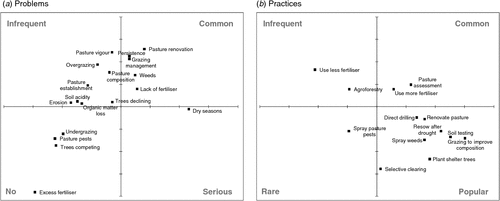
|
It also appears that producers regarded the resowing of pastures, using grazing management to influence pasture composition, soil testing and spraying for weeds as the most valuable practices available to them. Producers were less sure of the value of applying more fertiliser or using formal pasture assessment techniques. While many producers regarded planting tree shelter belts as a worthwhile practice, few regarded agroforestry as worthwhile. These results suggest that a majority of livestock producers in the region find current pasture and land management practices useful but these practices are not by themselves sufficient to result in the maintenance of productive, healthy, long-lived pastures.
Sheep grazing and feeding management
Of the producers surveyed, 76% indicated that they had been experiencing problems with sheep grazing and feeding management.
Fig. 2 contains the maps for sheep grazing and feeding management problems and practices, respectively. With regard to management problems, most producers regarded the cost of feed grain and fodder conservation and the quality and quantity of pasture feed as serious problems. Producers’ concerns about the quality and quantity of the pasture feed supply reflected their dependence on pastures as their primary feed source. Few producers appeared to find the condition of their ewes or weaners a problem. Also, relatively few experienced problems with tender wool or vegetable fault.
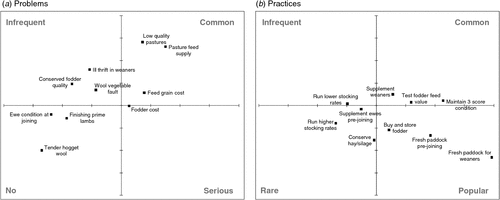
|
With respect to management practices, a majority of respondents believed that it was worthwhile to provide a fresh paddock for weaners and for ewes before joining. Consequently, relatively few respondents believed that supplementary feeding of ewes or weaners was worthwhile. Most respondents also believed it was worthwhile maintaining grown sheep in a ‘3-score’ condition (Waters et al. 2000) or better throughout the year. They were less sure of the benefits of conserving hay or silage and relatively few believed that changing stocking rate was worthwhile.
The results contained in Fig. 2 suggest that a majority of livestock producers in the region prefer to reserve pasture to meet the extra needs of weaners and ewes rather than to rely on supplementary feeding. This is consistent with their concern over the cost of feed grain and fodder. This reliance on pasture for feed is also consistent with producers’ perceptions that the quantity and quality of feed available from pastures are serious problems. These results mirror the results obtained in the previous section regarding the importance to producers of overcoming problems with the productivity, resilience, stability and longevity of pastures.
Sheep breeding and health management
Of the producers surveyed, 77% indicated that they had been experiencing problems with sheep breeding and health management. The maps for sheep breeding and health management problems and practices are presented in Fig. 3. Worm resistance stands out as the only serious breeding or health problem for sheep.
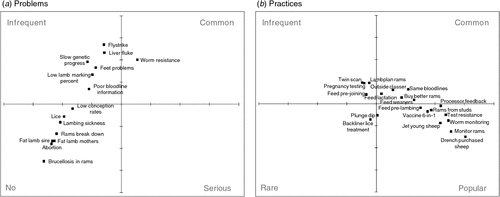
|
Most respondents believed it worthwhile to follow practices such as drenching, jetting, vaccination, worm monitoring and testing for drench resistance. They also believed it worthwhile to use registered stud rams, to buy dearer rams from bloodlines known to them, and to monitor the condition of rams before joining.
In contrast, relatively few producers thought it worthwhile to purchase ‘Lambplan’ (Banks 1990) registered rams, to scan for twins or to test ewes for pregnancy. While relatively few respondents believed it worthwhile to supplementary feed ewes before joining or during lactation, most believed supplementary feeding was worthwhile before lambing.
These results suggest that most livestock producers in the New England region do not experience serious problems with regard to sheep breeding or health although a substantial proportion experience problems with resistance to drenches used for the control of internal parasites. This suggests that there is a range of useful and effective breeding and health management practices available in the region.
Cattle grazing and feeding management
Of the producers surveyed, 78% of those with cattle indicated that they had been experiencing problems with cattle grazing and feeding management. Fig. 4 contains the maps for cattle grazing and feeding management problems and practices. An examination of the maps shows that producers regarded the quality and quantity of pasture feed as serious problems. Few producers appeared to find the condition of their cows or weaners a problem although some have experienced problems in finishing fat stock. Few have experienced problems with bloat or grass tetany.
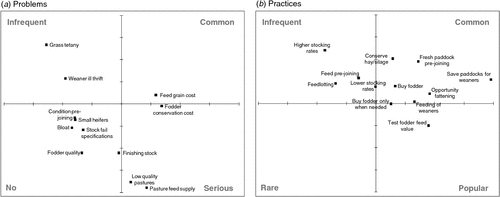
|
These results are similar to those obtained for sheep grazing and feeding management. In short, it appears that a substantial proportion of producers in the region have experienced serious problems with the cost of feed grain and fodder conservation and the quality and quantity of pasture feed.
Many respondents believed supplementary feeding of weaners, testing the feed value of fodder and opportunity fattening of store stock were worthwhile practices. Relatively few believed that supplementary feeding of cows and heifers was worthwhile although a majority of respondents believed it was worthwhile to provide a fresh paddock for weaners and for cows before joining. Again, respondents were less sure of the benefits of conserving hay or silage or of changing their stocking rate.
These results suggest that a majority of livestock producers in the region prefer to reserve pasture to meet the extra needs of weaners, cows and heifers rather than rely on supplementary feeding. This reliance on pasture means that the quantity and quality of feed available from pastures are serious concerns. These results are similar to those obtained for sheep and are consistent with the importance to producers of overcoming problems to do with the productivity, resilience, stability and longevity of pastures.
Cattle breeding and health management
Of the producers surveyed, 62% of those with cattle indicated that they had been experiencing problems with cattle breeding and health management. Fig. 5 contains the maps for cattle breeding and health management problems and practices, respectively. It appears that calving spread is the only serious breeding or health problem experienced by livestock producers.
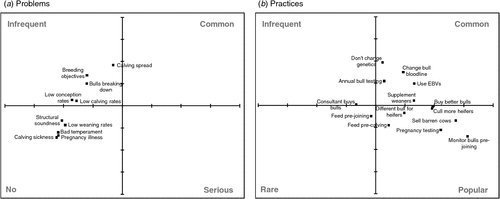
|
Most respondents believed it was worthwhile to follow practices such as pregnancy testing and culling cows and heifers that do not conceive. They also believed it was worthwhile to buy dearer bulls and to monitor the condition of bulls before joining. Approximately half believed it was worthwhile to use a different breed of bull with heifers and to only use bulls for which estimated breeding values (Meyer 1995) were available. While relatively few respondents believed it worthwhile to supplementary feed cows and heifers before joining, a higher proportion believed supplementary feeding to be worthwhile before calving. Only a minority of producers believed that annual bull testing was worthwhile.
These results confirm that a majority of livestock producers in the region had not experienced any serious problems with regard to cattle breeding or health whereas a small proportion had experienced problems with calving spread.
Open-ended questions
A total of 690 individual responses were received in response to the open-ended questions about land and livestock management. Most responses could be characterised as identifying district-specific problems which fell within one of the more general problem categories included in the survey. For example, one specific problem identified was ‘lovegrass infestation’, which falls within the more general problem category of ‘weeds’. Some responses consisted of generalised statements such as ‘costs of production too high’.
Overall, profitability issues, pasture and grazing sustainability and weeds were prominent in the land and pasture management section, with various specific pasture and animal health problems being suggested in both the feeding-grazing and the breeding-health sections, respectively. Generally, the answers to the open-ended questions paralleled responses to the sets of problems and practices put forward in the structured sections of the survey. However, the regional specificity of many answers in the various categories suggested that regional workshops might be valuable in developing detailed priorities for research and extension.
Commodity marketing
With respect to wool, only a small proportion of respondents had tried methods other than auction or direct sale to a wool buyer. Sale by auction stood out as the method that the largest number of wool producers identified as their preferred method of sale.
With respect to livestock, a high proportion of respondents had tried saleyard, paddock sales and selling direct to abattoirs. Both paddock sales and selling direct to abattoirs were identified as generating good results. Producers appeared less satisfied with saleyard selling or computer-aided livestock marketing.
In response to the open-ended questions for the commodity marketing section, producers identified various forms of direct selling and marketing to feedlots as methods which had been successful. Cattle marketing issues which were suggested for investigation by the Cicerone Project included the level of competition at auction and in the marketing chain, grading systems, improved market information and the formation of selling alliances with other producers. Wool marketing suggestions centred around information on futures and direct marketing along with improved market information.
Summary of results
A summary of the results regarding those problems rated as serious is presented in Table 1 below. The broad range of issues and sub-issues identified has presented a complex of challenges which can be summarised, in decreasing order of importance, as: successfully managing livestock enterprises through drought, avoiding costly supplements, grazing management, maintaining productive pastures of high quality, managing internal parasites, trees, soil fertility, wool quality and avoiding problems of inadequate animal nutrition, reproduction and ill thrift of weaners.
Expressions of interest
Overall, 76% of respondents expressed an interest in participating in the Project in one or more of the ways proposed, suggesting that the concept put forward by the Cicerone Project committee had strong support. Of these respondents, 73% indicated a willingness to be a partner, 40% to be a network member and 54% to be workshop participants. The spread of support across the districts indicated that there should be ample scope to spread the network across the New England region.
Discussion and conclusions
Surveys of farmers are recognised as having value for guiding research and extension programs (Chataway et al. 2003). A survey of livestock producers in the high rainfall temperate zone in 1994 (Reeve et al. 2000) found that graziers in the Glen Innes region of the Northern Tablelands reported pasture management problems requiring research including weed control and the poor persistence of sown species especially when challenged by drought, confirming the results of this survey across the New England region.
The results concerning land and pasture management suggest that a majority of livestock producers in the region find dry seasons, soil fertility, pasture composition and pasture persistence to be serious problems. This suggests that producers would welcome management innovations that would improve the resilience, stability and longevity of pastures in the region, much of which consists of native and unimproved pastures.
In terms of grazing and feeding management, a majority of producers prefer to reserve pasture to meet the extra needs of livestock rather than rely on supplementary feeding which reflects concern over the cost of feed grain and fodder. However, this reliance on pasture means that the quantity and quality of feed available from pastures represent serious problems for many producers.
Worm resistance and calving spread stood out as the most important breeding or health problems for sheep and cattle, respectively.
Nearly 80% of respondents expressed interest in becoming involved in the Cicerone Project in some way. This suggested the concept of a central learning farm combined with network activities and providing the opportunity for producer input were concepts that received strong support across the New England region. This is consistent with the findings of Robertson and Wimalasuriya (2004) who conducted a survey of 29 sheep producers in the Victorian Mallee region to identify current issues with sheep and pasture management and constraints to adoption. They concluded that, to increase rates of adoption, there was a need for the collection of more data and benchmarking of both livestock and pastures within grazing enterprises in order to be better able to demonstrate the link between the production data and farm profit.
This survey has identified a wide array of important issues for consideration by the Cicerone committee as it seeks to create a valued producer-led research, extension and adoption network. The results reinforce the view of Llewellyn et al. (2005) that asking farmers about their perceptions relating to farm management decisions can assist in focusing research and extension programs and that embedding findings about technologies within whole-farm systems can increase the effectiveness of extension efforts. The research conducted under the umbrella of the Cicerone Project focussed largely on the findings of this survey and is reported in detail in a range of companion papers in this Special Issue.
Acknowledgements
This study was supported by the Woolmark Co. We would like to express our appreciation to the members of the Cicerone Board and the Armidale and Glen Innes Rural Lands Protection Boards for their advice and assistance. We are indebted to Steve Love, Peter Dundon and Bob Marchant for their assistance in designing the survey. A special thanks to those graziers who took the time to complete the survey.
References
Alford AR, Griffith GR, Davies BL (2003) ‘Livestock farming systems in the Northern Tablelands of NSW: an economic analysis.’ (NSW Agriculture: Orange) Available at http://www.dpi.nsw.gov.au/research/areas/biosecurity/economics-research/reports/err12 [Verified 5 January 2012]Banks RG (1990) LAMBPLAN: an integrated approach to genetic improvement for the Australian lamb industry. Proceedings of the Australian Association of Animal Breeding and Genetics 8, 237–240. http://www.aaabg.org/livestocklibrary/1990/ab90041.pdf [Verified 5 January 2012]
Chataway RG, Doogan VJ, Strong WM (2003) A survey of dairy farmers’ practices and attitudes towards some aspects of arable-land management in the Darling Downs and South Burnett regions of Queensland. Australian Journal of Experimental Agriculture 43, 449–457.
| A survey of dairy farmers’ practices and attitudes towards some aspects of arable-land management in the Darling Downs and South Burnett regions of Queensland.Crossref | GoogleScholarGoogle Scholar |
Garden DL, Dowling PM, Eddy DA, Nicol HI (2000) A survey of farms on the Central, Southern and Monaro Tablelands of New South Wales: management practices, farmer knowledge of native grasses, and extent of native grass areas. Australian Journal of Experimental Agriculture 40, 1081–1088.
| A survey of farms on the Central, Southern and Monaro Tablelands of New South Wales: management practices, farmer knowledge of native grasses, and extent of native grass areas.Crossref | GoogleScholarGoogle Scholar |
Kruskal JB, Wish M (1978) ‘Multidimensional scaling. 11.’ (Sage Publications: London)
Llewellyn RS, Pannell DJ, Lindner RK, Powles SB (2005) Targeting key perceptions when planning and evaluating extension. Australian Journal of Experimental Agriculture 45, 1627–1633.
| Targeting key perceptions when planning and evaluating extension.Crossref | GoogleScholarGoogle Scholar |
Lodge GM, McCormick LH, Dadd CP, Burger AE (1991) A survey of graziers and pasture management practices on the Northern Slopes of NSW. NSW Agriculture and Fisheries Technical Bulletin No. 43, Sydney.
Meyer K (1995) Estimates of genetic-parameters and breeding values for New Zealand and Australian Angus cattle. Australian Journal of Agricultural Research 46, 1219–1229.
| Estimates of genetic-parameters and breeding values for New Zealand and Australian Angus cattle.Crossref | GoogleScholarGoogle Scholar |
Reeve IJ, Kaine G, Lees JW, Barclay E (2000) Producer perceptions of pasture decline and grazing management. Australian Journal of Experimental Agriculture 40, 331–341.
| Producer perceptions of pasture decline and grazing management.Crossref | GoogleScholarGoogle Scholar |
Robertson SM, Wimalasuriya RK (2004) Limitations to pasture and sheep enterprises and options for improvement in the Victorian Mallee. Australian Journal of Experimental Agriculture 44, 841–849.
| Limitations to pasture and sheep enterprises and options for improvement in the Victorian Mallee.Crossref | GoogleScholarGoogle Scholar |
Vanclay F, Hely A (1997) ‘Land degradation and land management in Central NSW: changes in farmers’ perceptions, knowledge and practices: a report to the New South Wales Department Agriculture and the Department of Land and Water Conservation.’ (Centre for Rural Social Research, Charles Sturt University: Wagga Wagga, NSW)
Waters CM, Coelli KA, Lee GJ, Atkins KD (2000) Reproduction effects on annual fleece production, liveweight and body condition of grazing Merino ewes. Australian Journal of Experimental Agriculture 40, 931–937.
| Reproduction effects on annual fleece production, liveweight and body condition of grazing Merino ewes.Crossref | GoogleScholarGoogle Scholar |
Whalley R, Robinson G, Taylor J (1976) General effects of management and grazing by domestic livestock on the rangelands of the Northern Tablelands of New South Wales. The Rangeland Journal 1, 174–190.
| General effects of management and grazing by domestic livestock on the rangelands of the Northern Tablelands of New South Wales.Crossref | GoogleScholarGoogle Scholar |



